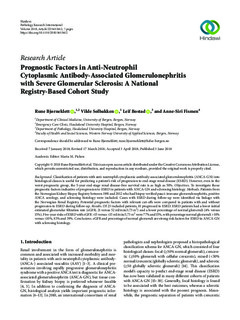| dc.contributor.author | Bjørneklett, Rune | |
| dc.contributor.author | Solbakken, Vilde | |
| dc.contributor.author | Bostad, Leif | |
| dc.contributor.author | Fismen, Anne-Siri | |
| dc.date.accessioned | 2019-01-10T14:15:38Z | |
| dc.date.available | 2019-01-10T14:15:38Z | |
| dc.date.created | 2018-11-16T20:11:09Z | |
| dc.date.issued | 2018 | |
| dc.identifier.citation | Bjørneklett, R., Solbakken, V., Bostad, L., & Fismen, A.-S. (2018). Prognostic factors in anti-neutrophil cytoplasmic antibody-associated glomerulonephritis with severe glomerular sclerosis: A national registry-based cohort study. Pathology Research International, 2018, 1-7. | nb_NO |
| dc.identifier.issn | 2090-8091 | |
| dc.identifier.uri | http://hdl.handle.net/11250/2580240 | |
| dc.description.abstract | Background. Classification of patients with anti-neutrophil cytoplasmic antibody-associated glomerulonephritis (ANCA-GN) into histological classes is useful for predicting a patient’s risk of progression to end-stage renal disease (ESRD). However, even in the worst prognostic group, the 5-year end-stage renal disease-free survival rate is as high as 50%. Objectives. To investigate those prognostic factors indicative of progression to ESRD in patients with ANCA-GN and sclerosing histology. Methods. Patients from the Norwegian Kidney Biopsy Registry between 1991 and 2012 who had biopsy verified pauci-immune glomerulonephritis, positive ANCA serology, and sclerosing histology were included. Cases with ESRD during follow-up were identified via linkage with the Norwegian Renal Registry. Potential prognostic factors with relevant cut-offs were compared in patients with and without progression to ESRD during follow-up. Results. Of 23 included patients, 10 progressed to ESRD. ESRD patients had a lower initial estimated glomerular filtration rate (eGFR; 21 versus 52 ml/min/1.73 m2) and a lower percentage of normal glomeruli (4% versus 15%). Five-year risks of ESRD with eGFR >15 versus ≤15 ml/min/1.73 m2 were 77% and 15%, with percentage normal glomeruli >10% versus ≤10%, 83% and 39%. Conclusions. eGFR and percentage of normal glomeruli are strong risk factors for ESRD in ANCA-GN with sclerosing histology. | nb_NO |
| dc.language.iso | eng | nb_NO |
| dc.publisher | Hindawi Publishing Corporation | nb_NO |
| dc.rights | Navngivelse 4.0 Internasjonal | * |
| dc.rights.uri | http://creativecommons.org/licenses/by/4.0/deed.no | * |
| dc.title | Prognostic Factors in Anti-Neutrophil Cytoplasmic Antibody-Associated Glomerulonephritis with Severe Glomerular Sclerosis: A National Registry-Based Cohort Study | nb_NO |
| dc.type | Journal article | nb_NO |
| dc.type | Peer reviewed | nb_NO |
| dc.description.version | publishedVersion | nb_NO |
| dc.rights.holder | Copyright © 2018 Rune Bjørneklett et al. | nb_NO |
| dc.subject.nsi | VDP::Medisinske Fag: 700::Klinisk medisinske fag: 750::Nefrologi, urologi: 772 | nb_NO |
| dc.source.pagenumber | 1-7 | nb_NO |
| dc.source.volume | 2018 | nb_NO |
| dc.source.journal | Pathology Research International | nb_NO |
| dc.identifier.doi | 10.1155/2018/5653612 | |
| dc.identifier.cristin | 1631586 | |
| cristin.unitcode | 203,3,50,0 | |
| cristin.unitname | Institutt for sykepleiefag - Bergen | |
| cristin.ispublished | true | |
| cristin.fulltext | original | |
| cristin.qualitycode | 1 | |

